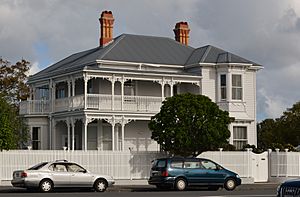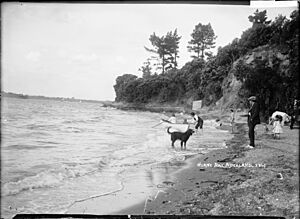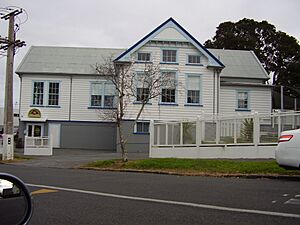Herne Bay, New Zealand facts for kids
Quick facts for kids Herne Bay |
|
|---|---|

A large wooden house on Jervois Road, in a style typical of Herne Bay.
|
|
| Basic information | |
| Local authority | Auckland |
| Electoral ward | Waitematā and Gulf ward |
| Local board | Waitematā Local Board |
| Land area | 88 ha (0.34 sq mi)* |
| Coordinates | 36°51′S 174°44′E / 36.850°S 174.733°E |
| Population | 2,820 (June 2023) |
|
|
||
Herne Bay is a cool suburb in Auckland, New Zealand. It sits right on the southwestern shore of the Waitematā Harbour. This area is famous for its amazing views of the harbour. It also has many beautiful old homes, especially those from the Edwardian era.
Herne Bay has been a popular and wealthy place since the 1850s. This is mainly because of its fantastic harbour views. It has often been ranked as one of the most expensive suburbs in New Zealand. For example, in 2021, the average house price was about $3.25 million. The local government for Herne Bay is the Auckland Council.
Contents
Herne Bay's Past
The name "Herne Bay" comes from a fancy seaside town in Kent, England.
From the 1850s, people realised Herne Bay was easy to reach from Auckland's city centre by boat. This made it one of Auckland's first suburbs where people lived and travelled to work. Many wealthy people built large homes here. These "marine villas" often had their own jetties and boathouses. Sometimes, the only way to get to them was by water! Some of these old houses are still standing today. They are now surrounded by newer homes built as the big properties were divided up.
There was also a fun place called Kemp's Gardens nearby. It was a popular spot for Aucklanders in the 1860s. The gardens had a pavilion, walking paths, and even lights at night. Later, it was renamed "Cremorne Gardens" after a famous London park. This park is remembered today by "Cremorne Street."
Herne Bay in the 2000s
In 2008, Herne Bay made history. It became the first suburb in New Zealand where the average house price went over $2 million. This shows how popular and valuable the area is.
Who Lives in Herne Bay?
Herne Bay covers about 0.88 square kilometres. In 2023, about 2,775 people lived here.
The population has changed a bit over the years:
- 2006: 2,982 people
- 2013: 2,940 people
- 2018: 3,036 people
- 2023: 2,775 people
In 2023, there were slightly more females than males. The average age was around 47.6 years old. About 13.9% of the people were under 15 years old. Most people in Herne Bay are of European background. Many also identify as Māori or Asian. English is the main language spoken. About a quarter of the people living here were born outside New Zealand.
Many people in Herne Bay have a university degree or a higher qualification. The average income in Herne Bay is higher than the national average. Most adults work full-time.
Local Schools
Herne Bay has two primary schools for younger students (Years 1-6):
- Bayfield School
- Ponsonby Primary School
Both schools welcome both boys and girls.
Famous Buildings in Herne Bay
Herne Bay has many interesting and historic buildings. Here are a few:
- Baptist Church: Located at 43 Jervois Road. This wooden church is built in a classic style. It has an organ that might be the oldest in Australia and New Zealand! It's believed Queen Victoria gave it to a church in Auckland a long time ago.
- St Stephen's Presbyterian Church: Found at the corner of Jervois Road and Shelly Beach Road. This is a wooden church built in the Gothic style, with a very impressive inside.
- Stichbury Terrace: At the corner of Jervois Road and Curran Street. This is an apartment building from around 1915, built in a Neo-Classical style.
- Ponsonby Primary School: The main building at 44 Curran Street is a great example of the Arts & Crafts style. It was built around World War I for schools. Before 1920, this land was a Chinese market garden.
- Shangri-la Apartments: At 97-103 Jervois Road. This tall apartment building from the late 1980s has only 16 apartments. Many of them take up an entire floor!
- Turret House: At 4 Shelly Beach Road. This is a large Edwardian house with a cool turret on the roof. It's now a bed and breakfast hotel.
- Dome House: At 11 Shelly Beach Road. This is an unusual and large Edwardian house. It's easy to spot because of its big domed turret on the corner.
- Stebbing Recording Studios: Located at 108-114 Jervois Road. This is a famous place where music has been recorded.
- Art-Deco Flats: At 175-183 Jervois Road. These are four apartment buildings built in the 1930s in the stylish Art-Deco design.
- The Gables: At 248 Jervois Road. This was the first pub built in this area in the early 1970s. It was designed to look like the old houses in the bay, which is why it's called "The Gables."
- Former Bayfield School: At 272 Jervois Road. This old wooden Edwardian school is now used for preschool activities.
- Williamson House: At 237 Jervois Road. This is an important Arts & Crafts style house built in 1928.
- Hawke Sea Scout Hall: At 55 West End Road. This building was first put up in 1928. It was rebuilt in 1952 after a fire, with timber given by the US Marine Corps. It has recently been restored to its original look.



